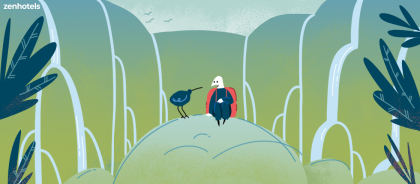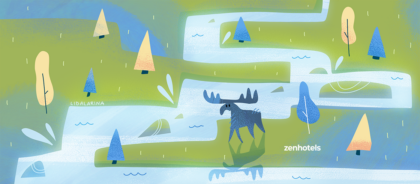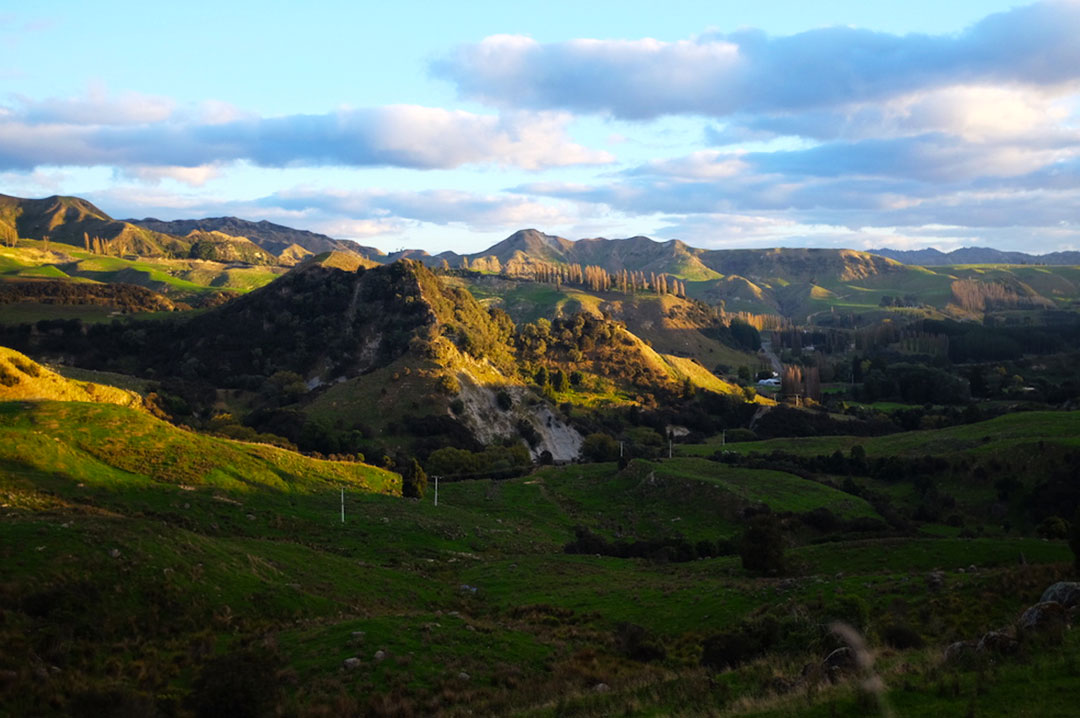
Route
In order to see all this, we planned to travel 3,500 kilometers in three weeks by car across both islands from north to south.
After our flight arrived in Auckland, we rented a minivan and were planning on making a detour to the north and then driving across the whole island to Wellington, the capital. Over the course of a week, we planned to see the suburbs of Paihia, Baylys Beach, Coromandel Peninsula, and Tongariro Park. After this, a ferry would convey us across Cook Strait to the South Island. From there, we planned to drive the minivan in the direction of Nelson and the vineyards of Marlborough Province, to see the Southern Alps and Mount Cook, to see Wanaka and Queenstown, the famous road to Milford Sound and the fjord itself. Then we were going to visit the southern Catlins region and the city of Dunedin before returning to Auckland by airplane from Queenstown.
Campgrounds
We were planning on spending the nights in cottages that are scattered across some of the campgrounds for almost the entire trip. There are usually several rooms in each cottage, or they are the type that have one room with bunk beds. As a rule, the showers, toilets, and kitchen are separate and are available for all of the campground’s guests.
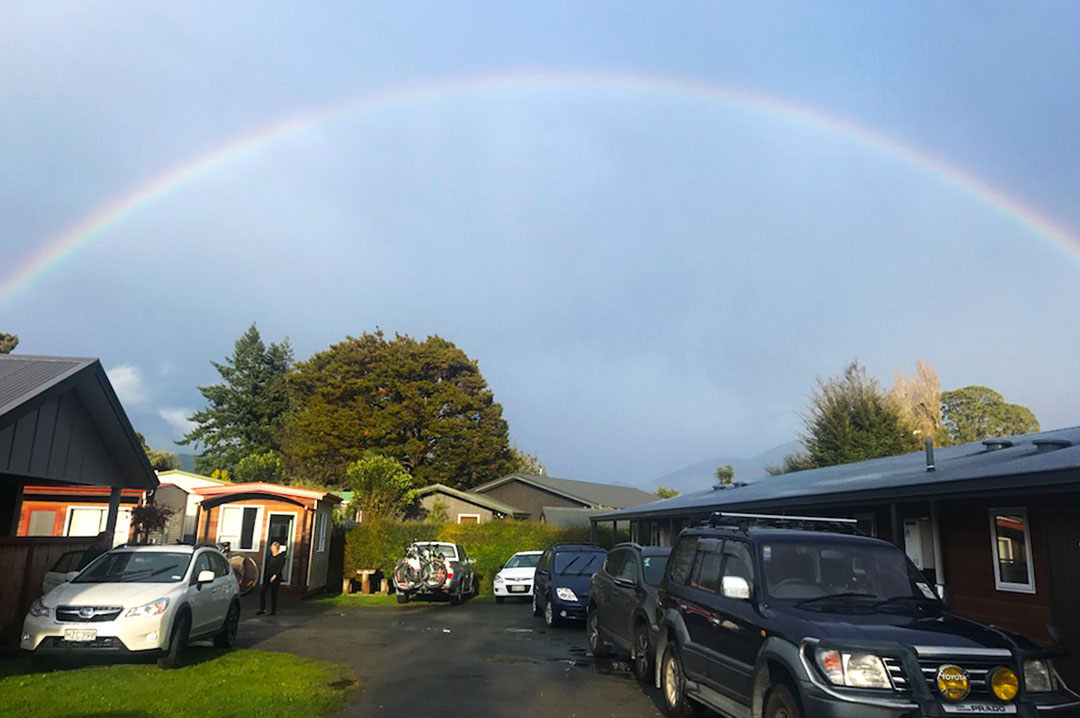
Sometimes there are trailers instead of cottages. These are real homes on wheels, inside of which the living conditions are even more spartan. But, generally speaking, people usually travel around New Zealand with backpacks, and they do not need five-star hotels.
The common kitchens are equipped with stoves and all the necessary dishes so campers can cook their own food. It’s best to stock up on groceries in large supermarkets such as Countdown and New World. The quality of the food is excellent, but prices are prohibitively high.
Groceries consisting of meat, vegetables, and herbs for salad, milk, muesli, yogurt, and a bottle of the local cider or wine ended up costing me $30-35 per day.
Arrival
The first thing travelers have to face after landing in New Zealand is jet lag (also known as time zone change syndrome). New Zealanders live in the future—they are 13 hours ahead of London. When you get there, your body has to adjust to the new rhythm. The main cure for jet lag is not to go to bed when you want to (perhaps you’ll want to go to sleep in the morning or during the day), but at night, at the same time, the New Zealanders go to bed.
I spent my first days in New Zealand in a suburb of Auckland with friends who had moved here. Auckland regularly ranks among the world’s most liveable cities due to its mild climate, good environmental conditions, and long life expectancy.
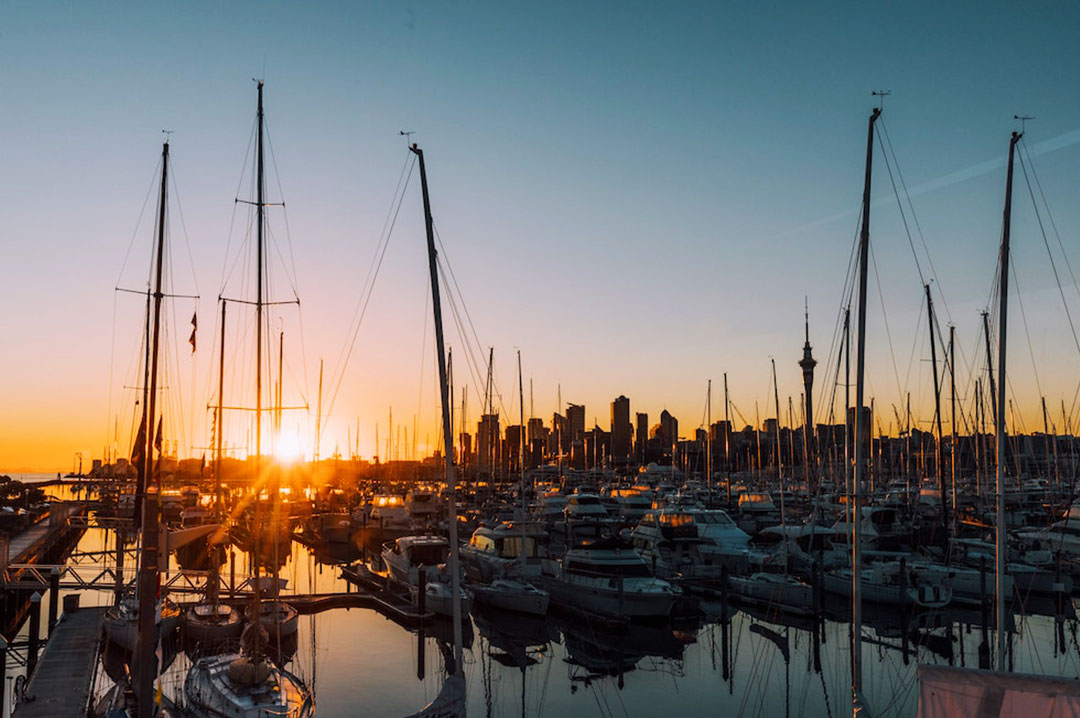
Auckland is a mixture of skyscrapers, greenery, and embankments—it’s cute but almost devoid of significant attractions. The suburbs of Auckland were more memorable to me due to their cozy houses with plenty of windows and light, and their green hedges, flowers, and beaches.
I underestimated the New Zealand sun and got sunburnt on the very first day despite using sun protective cream with SPF 50. This was how—with peeling skin on my forehead and nose—I appeared before our group the next day.
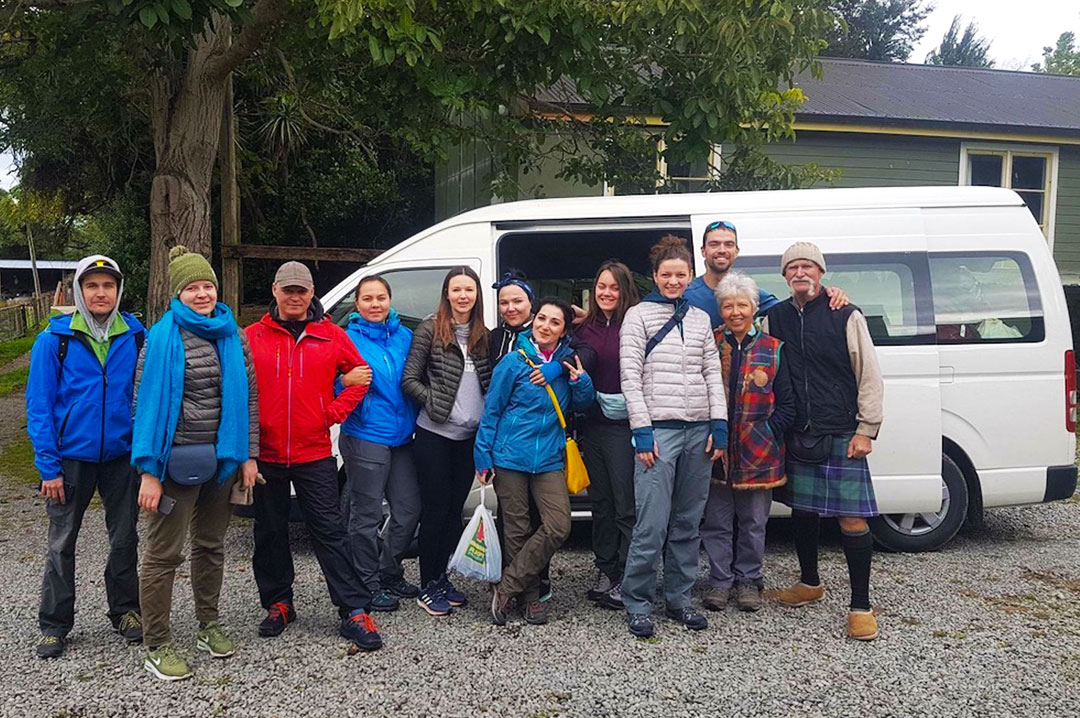
In addition to my friend and the guide, there were nine other adventure lovers on our team. The majority of them had lots of baggage from the other countries they had visited. We loaded our things and ourselves into the spacious minivan, got comfortable in our seats, and drove off—thus began our journey.
The first week
All the most interesting sites on the North Island are located outside of Auckland. Throughout the first week, we traveled all over the northern part of the North Island and visited beaches, parks, caves, and the famous Hobbiton movie set.
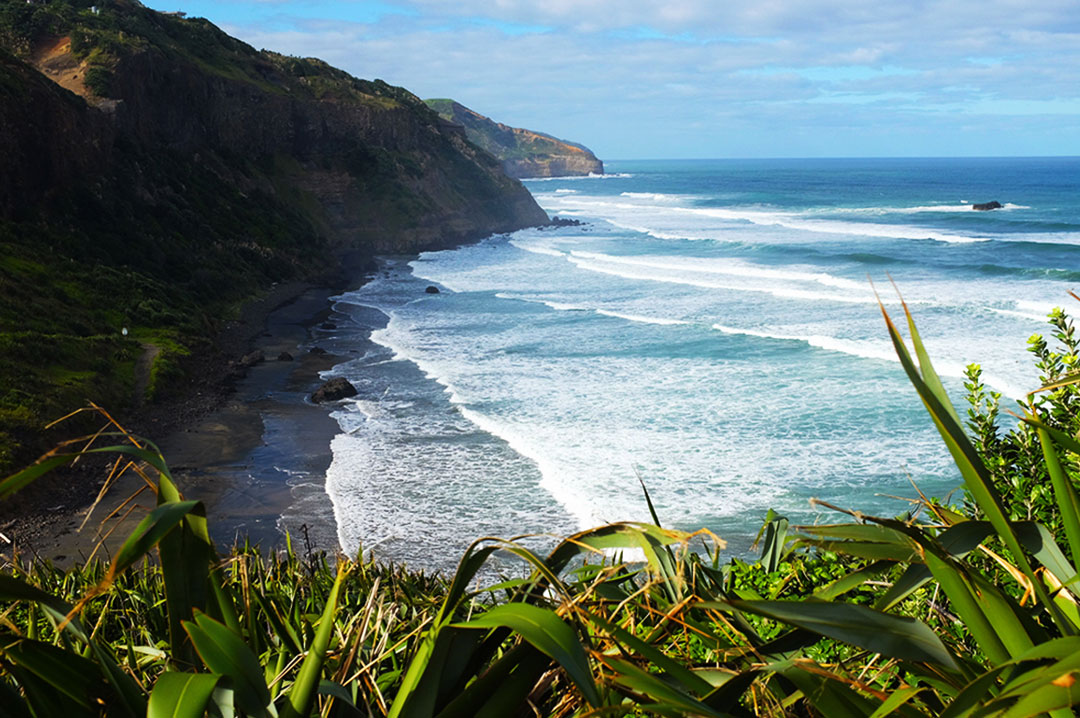
First, we went to the west coast, famous for its heavenly beaches for surfers and the Muriwai Gannet Colony. The journey from Auckland was only one hour. We observed adult birds feeding their chicks and watched the birds interacting with each other. Now I fully understand what a bird colony is. The cries of the gannets completely drowned out our voices.
The wooden steps and walkways for tourists led through thickets and bushes. For the first time in my life, I saw a silver fern—the symbol of New Zealand. This plant isn’t found anywhere else in the world. It’s been said that the indigenous Maori people made paths by laying silver fern fronds on the ground in order to find their way in the terrain.
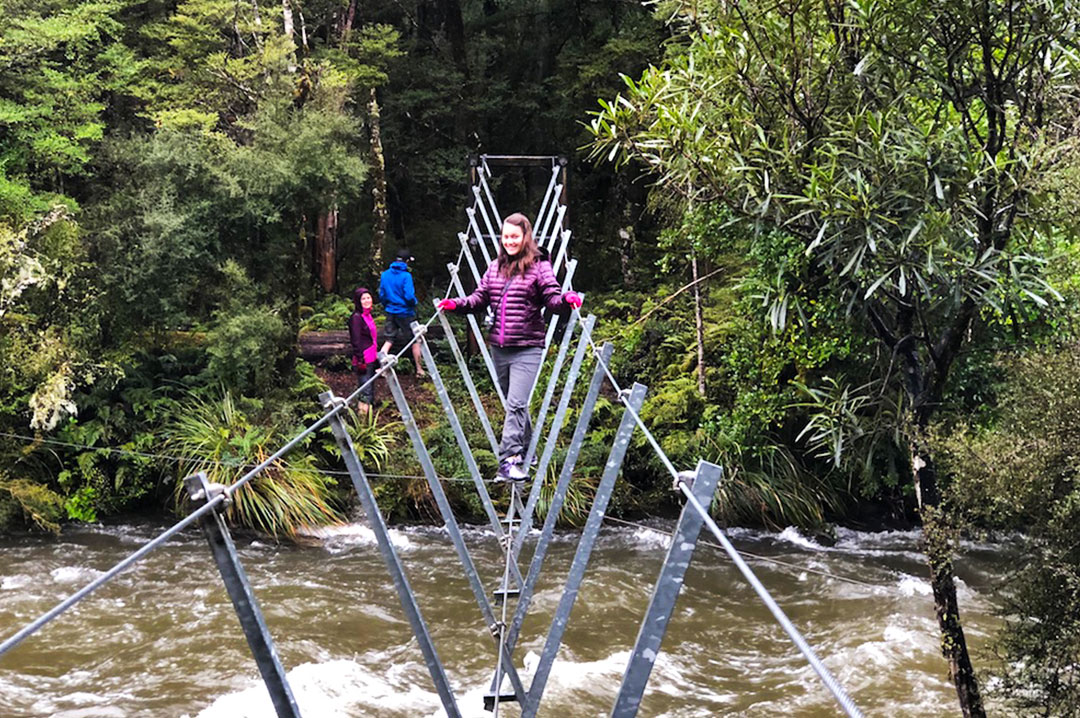
After that, we drove to the Waipu Caves. They are known for their glow worms (the luminous larvae of small flies). In order to catch food, the larvae weave traps of 30-40 cm long silk filaments coated with drops of sticky paralyzing fluid. The larvae highlight the filaments with their bodies, thus attracting their prey (insects). After getting stuck on these filaments, the victims don’t stand a chance of surviving.
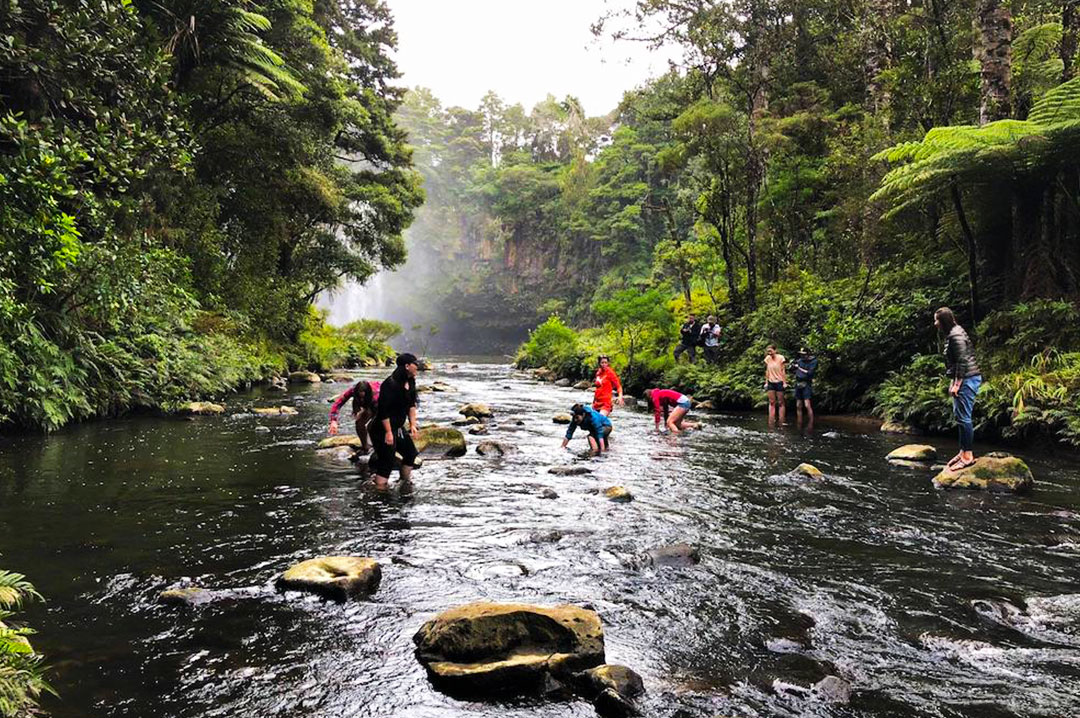
In order to get to the caves, we had to wade through several underground streams—the water was up to our waists in some of them. Going forward was a bit scary, even with flashlights and a guide who had already been to these places many times. When we finally got to the big cave with the domed ceiling, he asked us to turn off our flashlights. It seemed at first that we were in total darkness. But then our eyes got used to it, and we looked up and froze on the spot: it was like looking at a starry night—and it was the glow worms! The sight was so breathtaking that for the first minutes we just stood and stared with open mouths.
The next days were spent admiring eucalyptus and kauri trees. The former are interesting because they shed their bark rather than their leaves, so they look rather unusual. But even the eucalyptus trees pale in comparison with the exotic kauri—the most ancient coniferous trees, which outlived even the dinosaurs.
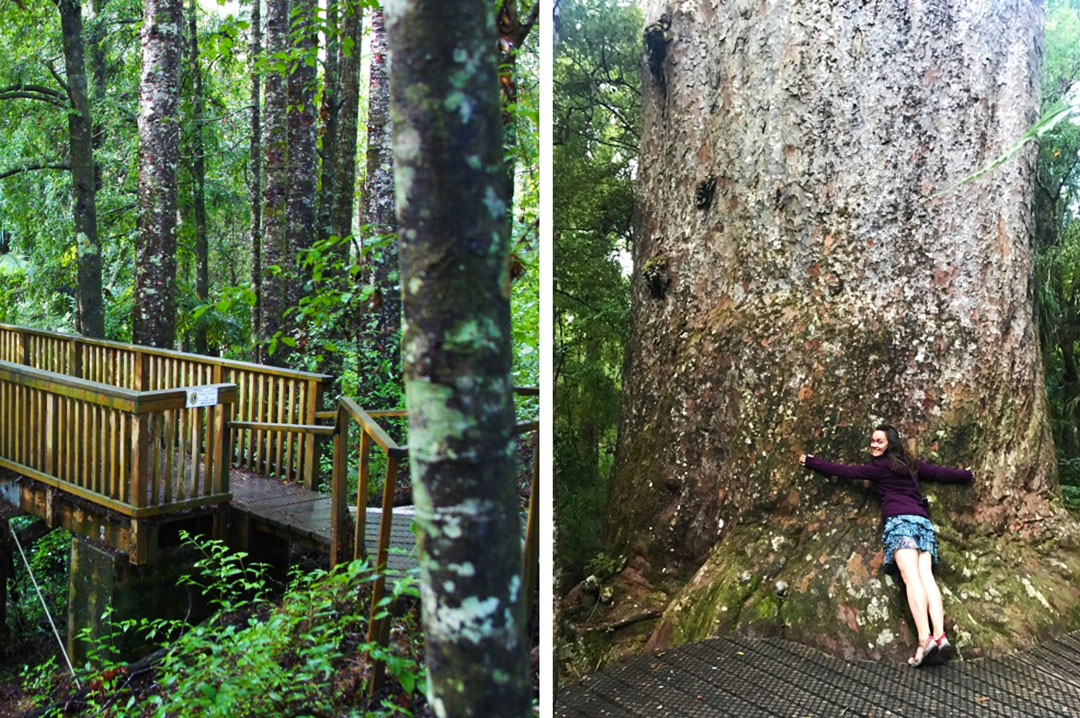
They grow up to 50 meters high and the growth of their trunk may be as great as 16 meters. Even if our whole group were to hold hands in a line and encircle the kauri, we would not be able to reach all the way around it. However, it’s not easy to get near a kauri: they are fenced off at parks so tourists do not trample down their roots. We went to the A. H. Reed Memorial Kauri Park to see the kauri forest. Entrance to the park is free.
How the locals conserve nature
I have never seen a place where people care so much about nature conservation as they do in New Zealand. There were even footwear cleaning stations at the entrance to the A. H. Reed Memorial Park. Kauri trees are prone to diseases caused by harmful microorganisms in the soil, so each person who visits the park steps on a platform with soap suds, lets the brush scrub the soles of their shoes, and then rinses them with water. Moreover, nobody is watching to make sure you follow the rules—it’s all up to the tourists’ conscience.
Efforts have also been made for the tourists. All wooden walkways on the trails of the national parks are covered with a grating, so they don’t get slippery when it rains. There are markings and signs everywhere. If there are warnings or requests not to climb on one of the paths or not to feed wild birds, they always explain the reason why. There are toilets at the park entrances, and they’re almost always perfectly clean.
The most memorable morning was at Baylys Beach. This is a long strip of pale yellow pristine sand that leads to the roaring ocean. We arrived at the beach at around eight in the morning. There was not a soul around us except for the seagulls, so we instantly changed into our swimsuits and rushed to jump into the waves.
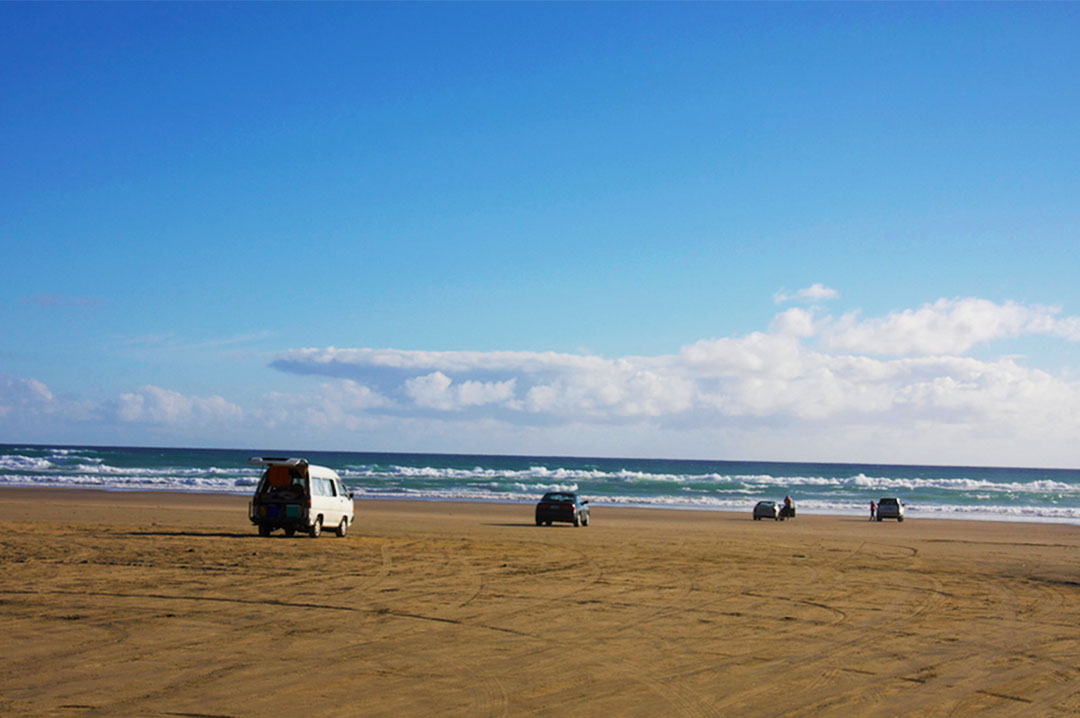
That evening, we reached the Coromandel Peninsula—where the majority of Aucklanders dream about having their country home. Thousands of stars twinkled overhead; the constellations were often strange for us because we’re accustomed to the sky of the Northern Hemisphere, not the Southern Hemisphere. The Star Walk mobile app (for iPhone, for Android) was helpful, and we were able to determine what we were seeing with it. In addition to the stars, we saw planets—Jupiter, Saturn, and Mars.
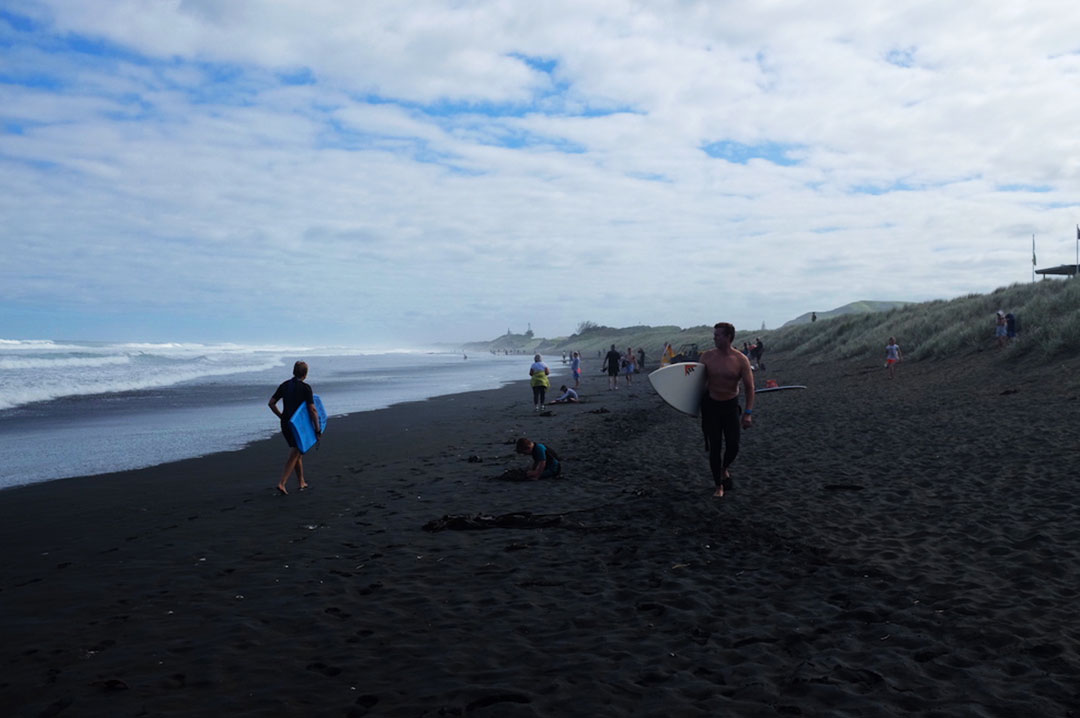
We got up at 4:30 in the morning to see the sunrise on the beach, and not just on any old beach, but while sitting in hot springs. We grabbed shovels to dig up the sand. Hot Water Beach did not get its name by accident: there are hot springs hiding in the sand, and we dug ourselves a bath.
Somebody from our group finally shouted out “water!” But the water turned out to be too hot, even impossible to stand in. For this reason, we dug a trench to the ocean in order to add cool ocean water to the hot water. Our plan was successful, so we changed into our swimsuits and sat down in the pool.
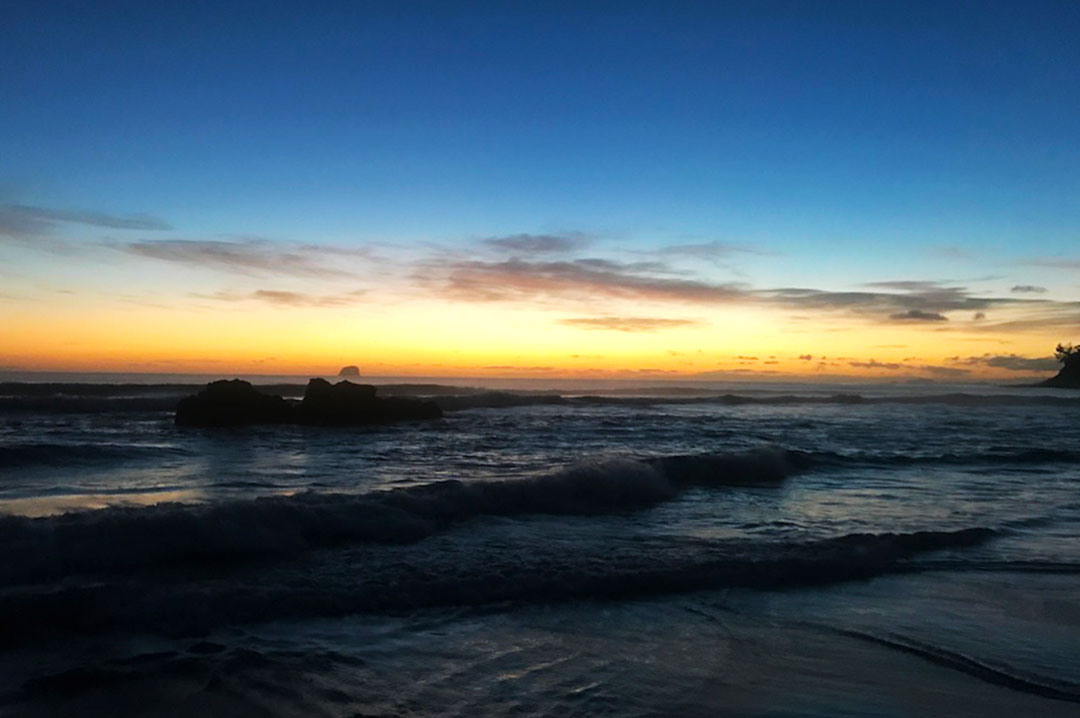
Meanwhile, the day was dawning—the bright red sky became tinged with pink, and then colored with hues of yellow and orange. I have never seen such a beautiful sunrise except perhaps in the Altai region of Russia.
After breakfast, and still with our heads spinning, we traveled on further to the famous Hobbiton. This place became a real mecca for The Lord of the Rings fans—scenes from Peter Jackson’s movie were filmed here. The director is from New Zealand, and they are very proud of him here.
Some facts about Hobbiton
You won’t be able to stroll along the back streets of The Shire—the country of hobbits invented by Tolkien—without being part of a group. To avoid chaos, visitors are led around in organized groups. The admission fee for adults starts at $58.
The gardens and hobbit houses are the sweetest little things, but you won’t be able to go inside them—the majority of houses are just wooden panels with a door and windows attached to a hill. There’s nothing inside them.
According to Tolkien, Bilbo’s lair was under a huge oak tree. Not finding anything suitable close by, the builders brought a tree from a nearby forest. First, it was cut into pieces, then assembled, and then its real leaves were replaced by artificial ones. The structure turned out to be impermanent, and, after some time, it was replaced with a synthetic tree made from optical fiber. It’s hard to distinguish the tree from a real oak except that its leaves hardly sway in the wind at all.
Hobbiton was built over two years, but the filming only lasted 12 days—so much work for just a few episodes.
By the fifth day, we had already traveled hundreds of kilometers. I was really looking forward to the trip to the Ngauruhoe volcano because I wanted to stretch my legs not just for a couple of hours, but for at least half a day. The volcano is famous for being used as a stand-in for the fictional Mount Doom in The Lord of the Rings film trilogy. Frodo climbed on top of its peak to throw the One Ring into the flames.
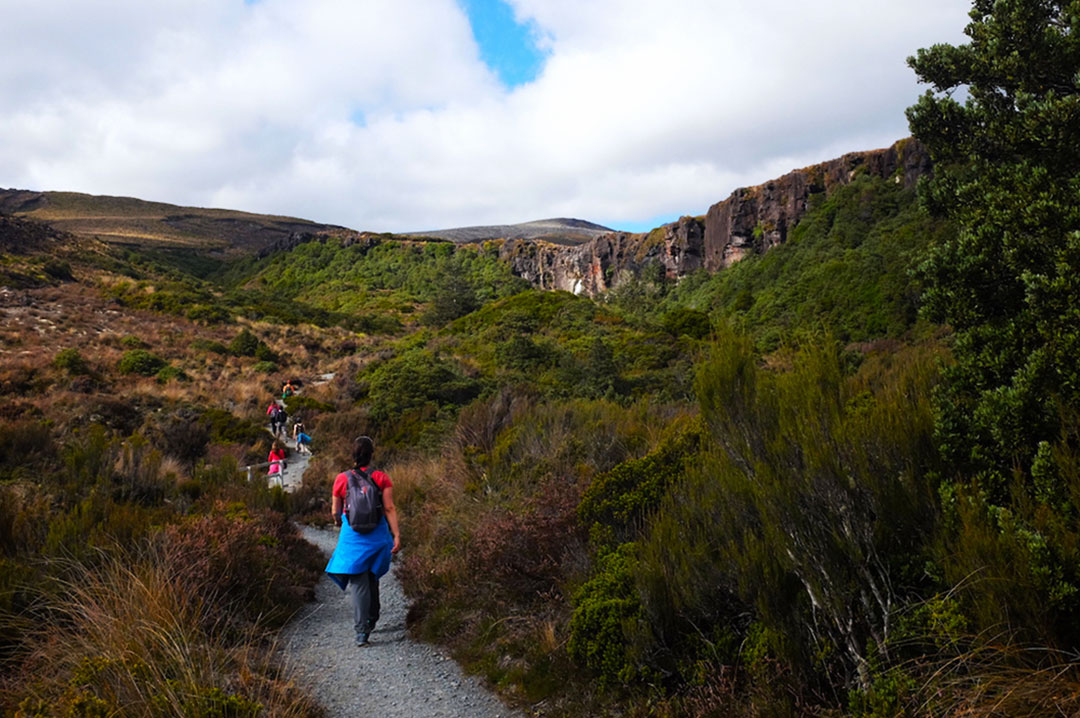
At the beginning of the route, the trail was picturesque, and we saw a variety of vegetation. The higher we climbed, the more monotonous the landscape became. Due to the steady climb, our legs began to ache pleasantly. We began our hike dressed in t-shirts and sun hats, but we ascended to the volcano wearing wind-proof jackets with hoods—the wind was so strong it swept us off our feet and threatened to blow into our ears.
There are two lakes hiding in the crater of the volcano, and we saw them too. But most interesting of all was being able to climb up close to the volcano—it looked exactly like Mordor from The Lord of the Rings with the same boulders and the very same landscape.
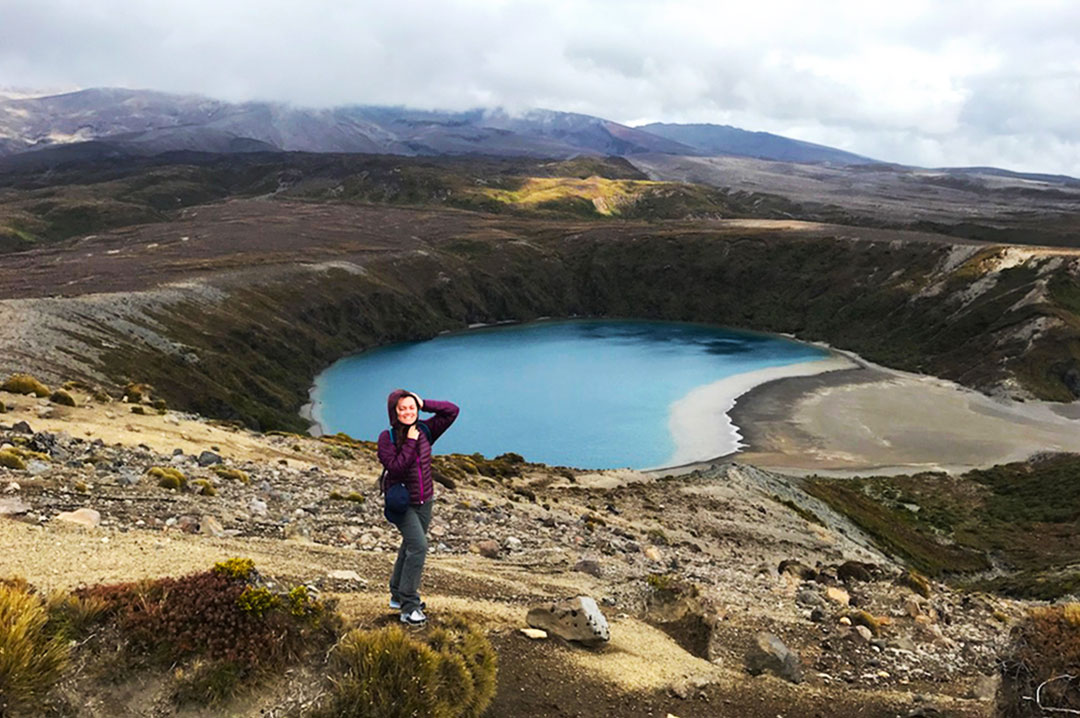
After the hike, there was a long transfer ahead of us, this time to Wellington, the capital of New Zealand. The city is noted for its winds and unpredictable weather. While driving into the city, we encountered drizzling rain, while the gusts of wind were stronger than they were at Ngauruhoe volcano.
At that time, the Homegrown Music Festival was taking place in Wellington, and young people from all over New Zealand had arrived in the capital—there were blonde girls in short skirts and sporty guys with tattoos. Concert tickets were already sold out, but we were feeling good even without going to it. After eating freshly caught fish at a café, we went for a walk around town and watched the people passing by. We wound down that evening at a trendy bar called The Library, celebrating our last day on the North Island.
What foods to try
New Zealand’s cuisine is a mix of European, Asian, and Polynesian dishes. One of the national dishes is roast kumara. This is a sweet potato that’s fried in homemade sour cream until it turns golden brown. A popular dish among the indigenous Maori people is hāngi—vegetables and meat cooked using heated rocks in a pit oven.
New Zealanders are steak lovers. We also tried the steaks: we bought the meat at a supermarket and cooked them at campground kitchens, adding vegetables as a garnish. The average cost of a steak in a café is $27. Dining at restaurants ends up being more expensive than stocking up on food at stores and doing your own cooking.
In port cities like Wellington, fish is popular. At a café, a fish dinner with a side salad and fries will cost $13-20.
Jerky is popular as a snack, and it costs $6-7 for a small portion.
In Queenstown, you must stand in line and try the famous burger at Fergburger. The price of a burger starts at $8.50. There’s talk that visiting businessman repeatedly tried to buy a franchise from the hamburger restaurant’s owner, but he remained unconvinced.
The second week
The locals say that the South Island is a lot more beautiful than the North Island. “How could it possibly be more beautiful?” we thought while boarding the ferry that was to take us from Wellington to the city of Picton on the South Island. I still can’t decide which island was more memorable for me, but I know for sure that not everything on the South Island can be seen on the North Island.
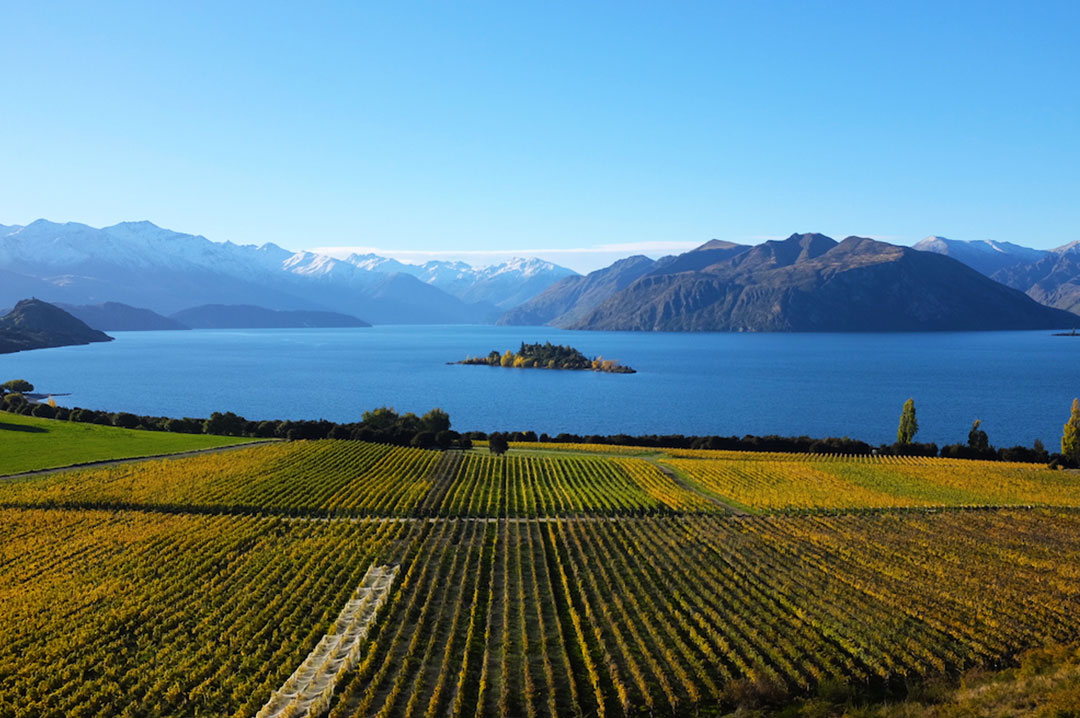
The guide took us to the vineyards in the renowned Marlborough region, the origin of the famous New Zealand wines. The wine tasting procedure is simple: after having learned your preferences, the vineyard’s employees will select suitable wines and pour them into glasses to try. During one tasting session, we sampled five different wines. You can buy the wines you liked right on the spot.
Which wines to try
The most popular grape variety in New Zealand is Sauvignon Blanc, which makes the most delicious white wine. This variety was brought over from France. After coming to New Zealand, its taste changed slightly—it became brighter and its fruit notes became more intense. The country’s best wine-producing regions are Marlborough and Hawke’s Bay.
Wine prices vary—a bottle of good wine costs anywhere from $10.50 and up in stores. Prices may be higher at the vineyards. Many of the wines presented at vineyards can be bought much more cheaply at supermarkets such as Countdown or New World.
You can download the Vivino app to your phone to make your selection easier. With this app, you can photograph the label on the bottle and find a description of how the wine tastes, its rating, and what other people wrote about it.
That day, we did not stay at a campground, but on a real farm with a family that had moved to New Zealand from Scotland. We didn’t find any other suitable accommodation options nearby, so we discovered these folks on the website that helps travelers find accommodation on farms.
The host greeted us dressed in a kilt (the traditional Scottish plaid skirt), and he also had a real mustache. All the women in our group rushed to get their photo taken with him. That evening, we gathered around the fireplace and shared our impressions of the trip, but didn’t dare stay too long. The next day, we set off for Mount Cook.
Mount Cook is the highest peak in New Zealand. It is located in the Southern Alps—one of the most beautiful regions in the country. We traveled from the area near Nelson, with its beaches and golden sand, into a realm of snow. I couldn’t comprehend how just yesterday we were running barefoot along the ocean shore, and today snow was crunching under our hiking boots.
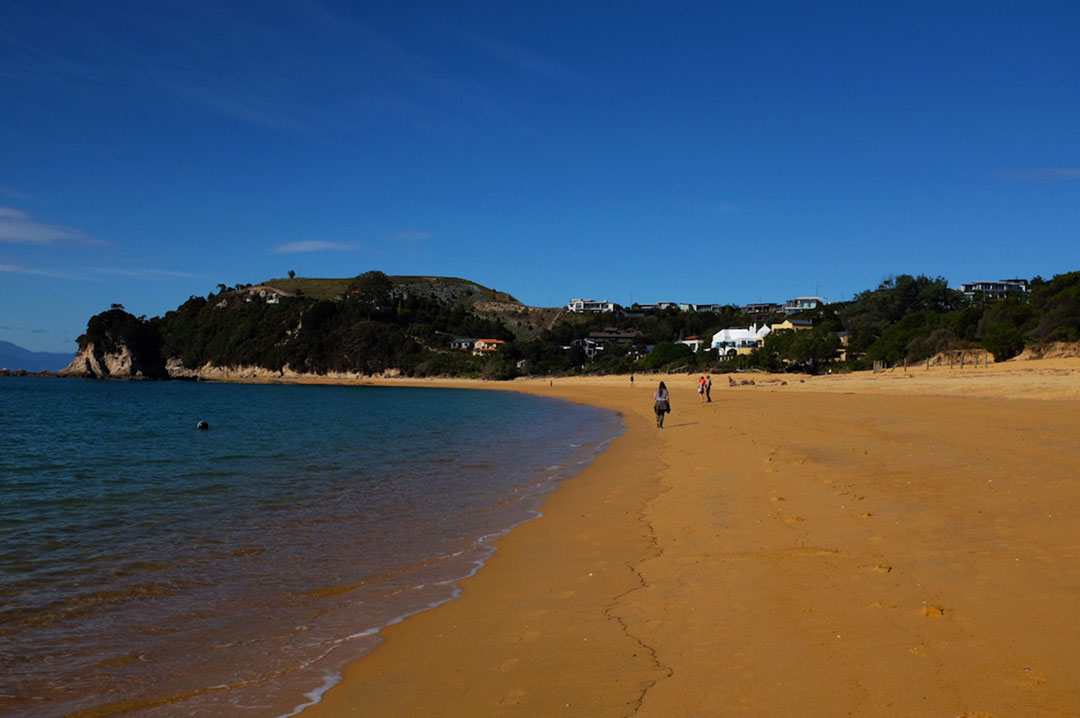
Our route took us further to the town of Wanaka. This is the most beautiful place to see the fall season in New Zealand: there are yellow, orange, and red trees of all shapes and sizes.
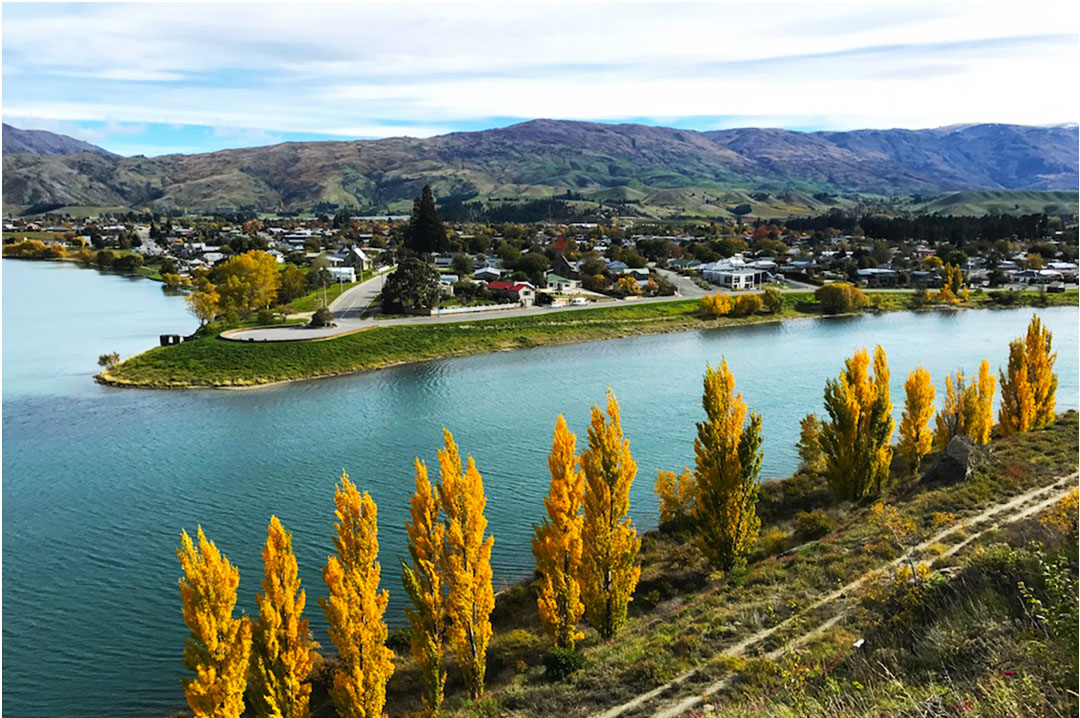
From Wanaka, we set off on foot to the Rob Roy Glacier. From start to finish, the route is a ten-kilometer climb with stunning alpine landscapes—turbulent rivers, green meadows, and mountain ranges lay ahead of us. On top of this, the sky was incredible with clouds resembling cotton candy—you really wished you could reach out and touch them.
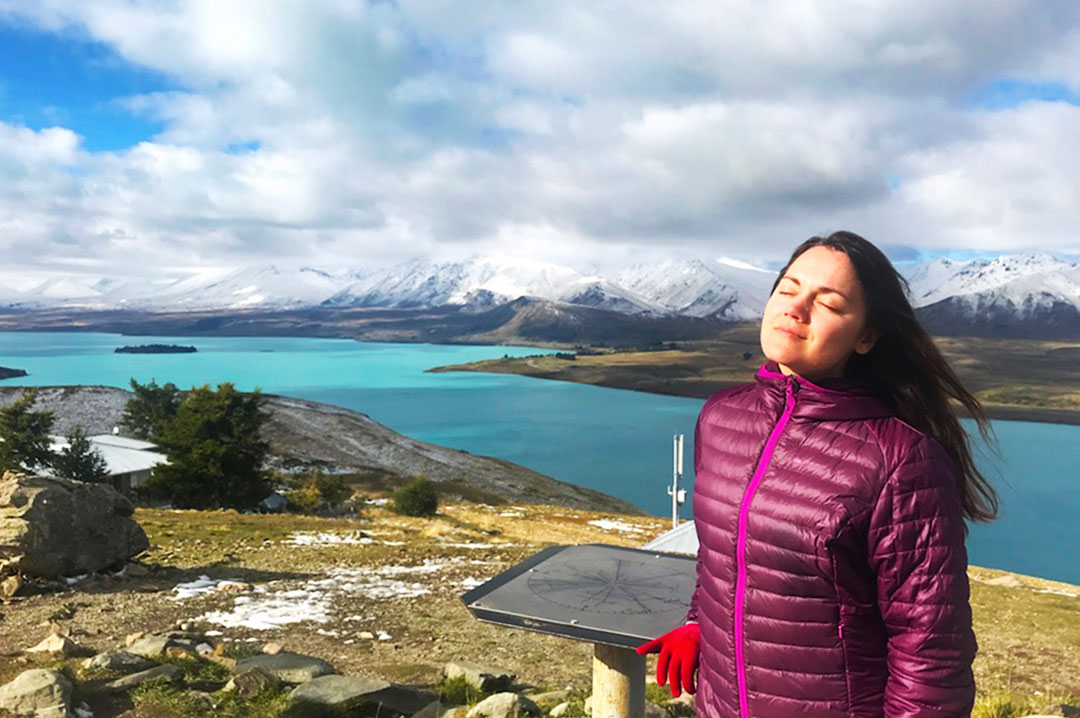
You meet other hikers along the way. You also come across sheep—in New Zealand, sheep outnumber people 7:1. But they say that sheep will soon be outnumbered by cows.
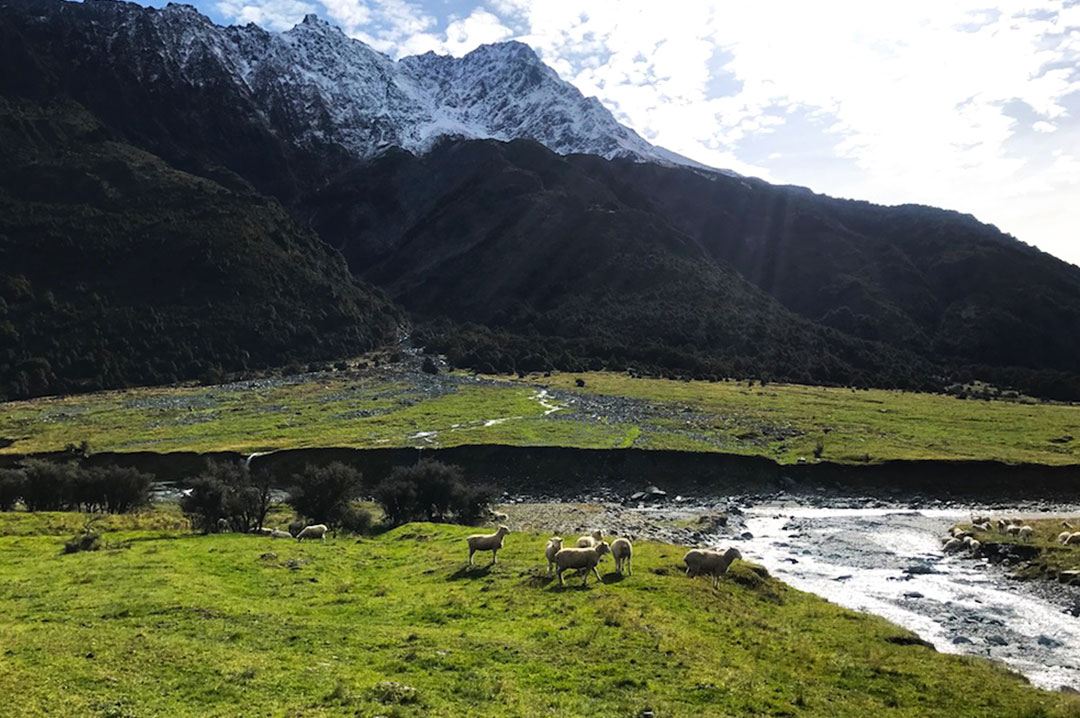
From here, it’s only a stone’s throw to Queenstown, the capital of extreme sports in the south-west of the country. This was where they came up with the idea of bungee jumping (jumping from dizzying heights while connected to a long elastic cord). Part of our group was eager to try bungee jumping, but we rented bicycles (a 3-4 hour bike rental costs about $15) and rode while admiring the views along the coast of Lake Wakatipu.
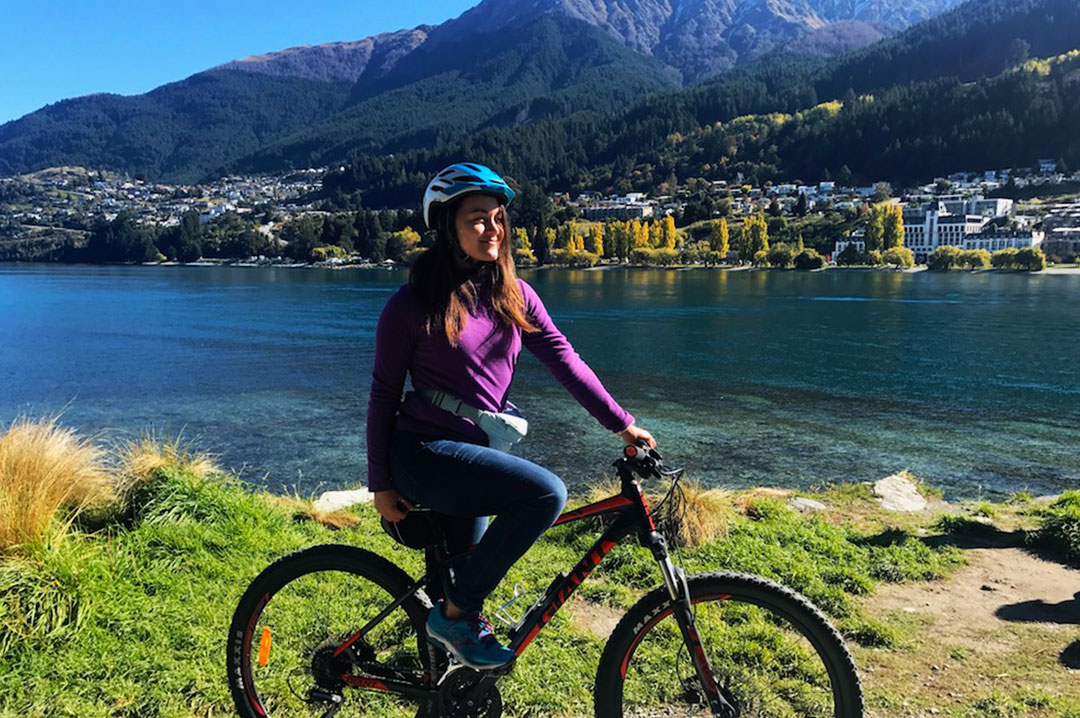
We were planning on riding for about 15 kilometers, but nature ended up being so stunningly beautiful that we simply could not stop—our pedals just kept on turning. When we returned our bicycles, we found out that we had actually ridden 80 kilometers!
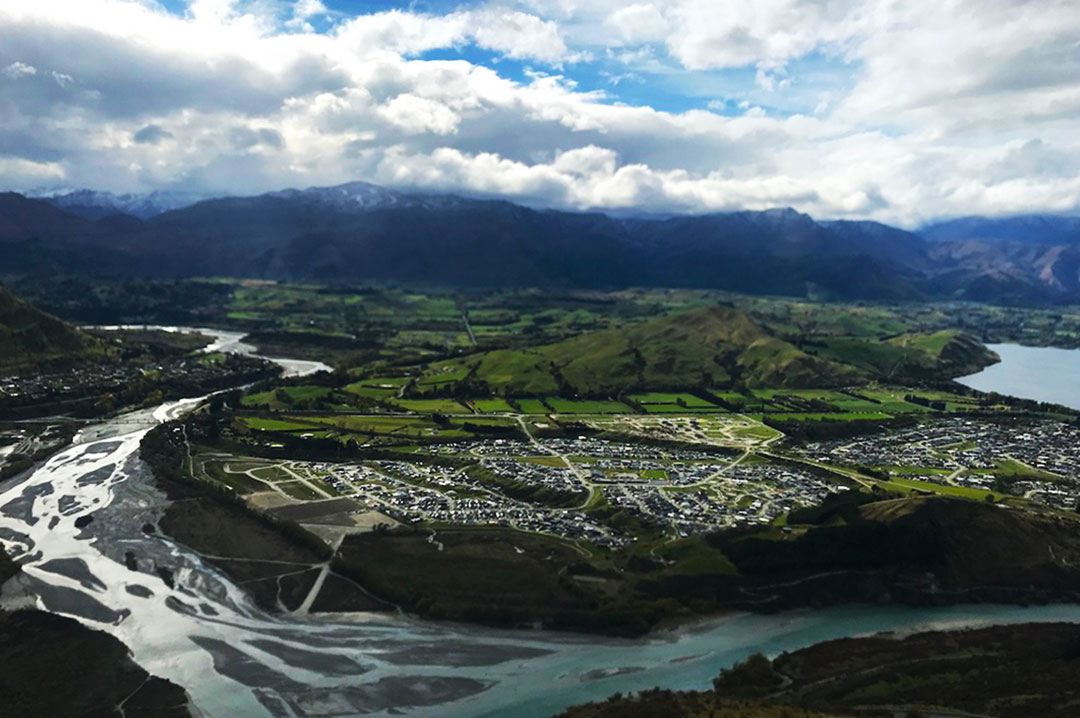
Everywhere you look, Queenstown is a delight for the eyes—on one side there are mountains, and on the other side is the crystal clear water of the lake. Paragliders dot the sky, and sailing yachts cleave the mirror-like lake.
New Zealanders are down-to-earth people
I don’t know if I have ever met such polite and smiling people as the New Zealanders. They greet each other on minibusses, ask how you’re doing when you buy goods at the supermarket, and offer to help even if you didn’t ask for it. Communicating with them is easy. Once we were in a café taking shelter from an Antarctic storm—the wind was so strong it blew the car off the road. There was a surprisingly beautiful elderly woman standing behind the cash register. We couldn’t help but tell her that she looked absolutely great. “Oh, thank you! You’ve cheered me up! With the weather this morning, I felt like a piece of crap.” We laughed heartily with her.
As for elderly people—you’d be amazed at how many of them we saw on the hiking trails! They can be seen walking with backpacks and Nordic walking poles, holding hands, and smiling. I heard that, like in Canada, they talk about retirement plans with enthusiasm: “Oh, we already have our route planned out for the summer—we’ll hike to the fjords, go kayaking in the next region, and then rent a house on wheels.”
The third week
Our last week in New Zealand was bound to be the cherry on top because we were heading in the direction of the famous Milford fjord. During this time, we managed to survive a parrot attack, be evacuated from a fjord, and even meet sea lions face to face.
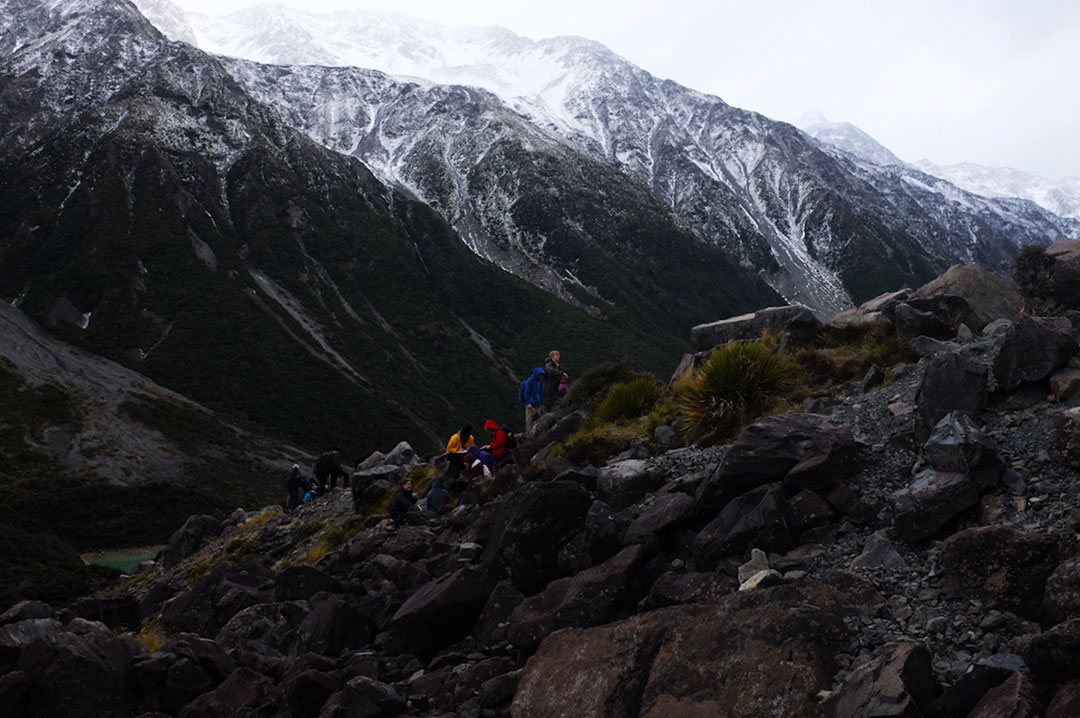
Milford Road—the road to Milford Sound—is renowned for its views of cascading waterfalls. We hardly had time to open the car door on one of the passes, when we saw a kea parrot rushing towards us. This bird is endemic to New Zealand and is specially protected by the locals. The kea, on its powerful short legs, ran towards the minivan and began to gnaw on the tires; the kea did not respond to our threats.
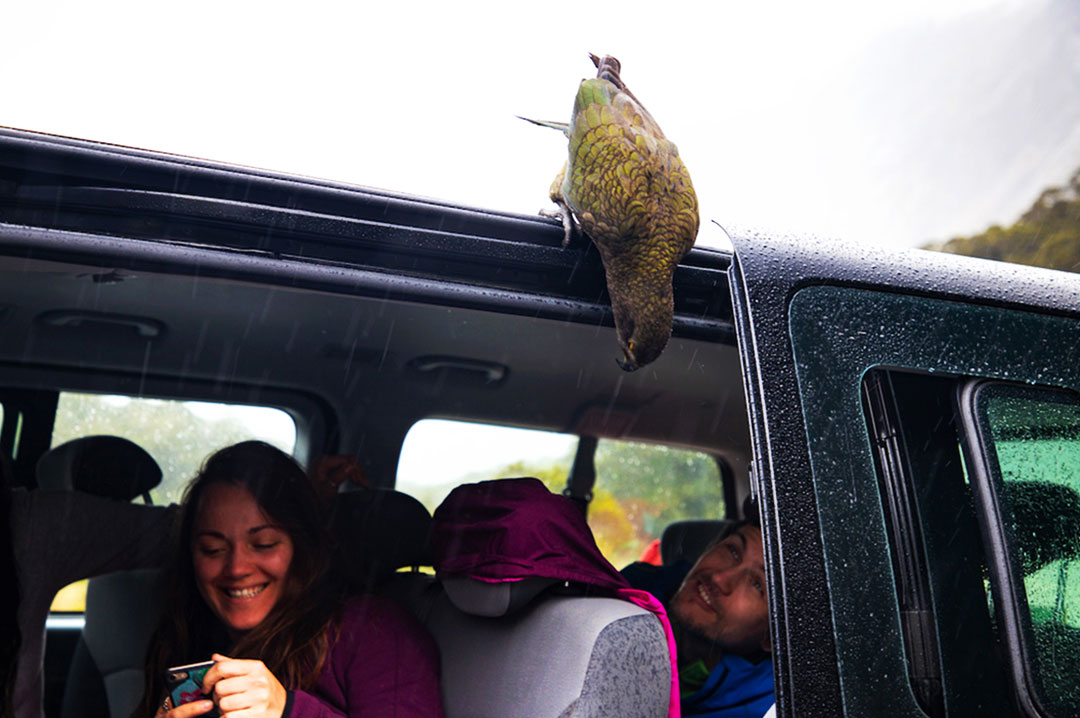
Before long, there were several kea birds. It’s evident that parrots live very freely and easily in New Zealand and have completely lost their fear of humans.
A kiwi, but not the fruit
There is another bird, the kiwi, that has managed to become the real calling card of New Zealand. However, it’s not easy to see the kiwi bird in the wild because it’s nocturnal. According to a legend, once upon a time, insects were attacking the earth and began to eat all the vegetation. At that moment, Tāne Mahuta, the Maori god of forests and of birds, asked all the different birds to do something about it. It was only the kiwi birds who heeded his cry for help. “You will lose the ability to fly, you will grow a disgusting beak, and your legs will become thick to make it easier to dig up insects,” Tāne Mahuta warned them. This did not stop the kiwis. So this is the reason why they got their unusual appearance.
It was already evening when we drove to the fjord. Kipling called Milford Sound the eighth wonder of the world. Milford Sound was formed by melted glaciers: the glacial water, searching for a route to the sea, moved mountains and stones on its way and filled up the lacunas that had been carved out. Milford Sound is surrounded on various sides by cliffs, and the noise of the hundreds of waterfalls can be heard from any point.
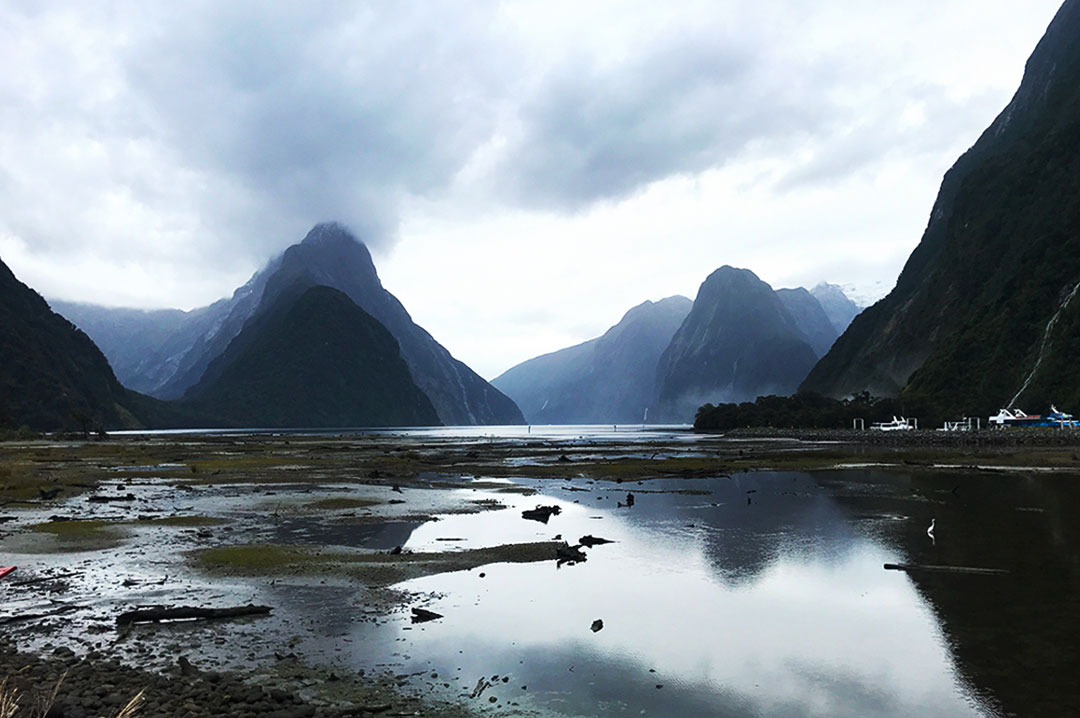
We were planning to go on a cruise the next day, but the weather abruptly changed for the worse. While we were having breakfast at the campground, administrators ran up to us and said that the road to Milford Sound was soon to be closed due to bad weather. In that case, we would not be able to return, and we would end up being stuck in the fjord for a couple of days. Tossing aside our spoons with porridge, we began frantically packing things into the car. We drove as fast as we could. A line of cars taking other tourists away from the fjord formed behind us. These are beautiful places, but that doesn’t mean that anyone would want to be stuck there for a couple of days in bad weather. Fortunately, we managed to get out before the road was closed. Then we drove further south.
Great Walks
There are nine Great Walks in New Zealand. These are hiking routes that take 3-5 days to complete. Three of the walks are located on the North Island, five are on the South Island, and one is on Stewart Island (Rakiura National Park). In 2019, another hiking trail will appear in Paparoa National Park on the South Island.
If you would like to prolong your stay in the Milford Road area, then the Milford Track Great Walk is just the ticket since this route is completely dedicated to the road to the fjord.
Catlins is an area in the south-east corner of the South Island where there are certainly more sheep than people.
The most memorable place is the Cathedral Caves. During low tide, you can wander through the caves’ entrance portals, and then climb on the cliffs, hiding from the ocean waves during high tide. This is quite the attraction—even pensioners from a group we met were squealing like kids. The caves are open to visitors from October to May.
Having received our dose of adrenaline, we headed for Kaka Point. It got its name from the New Zealand kaka bird (a species of parrot). A winding, scenic road leads to a lighthouse there.
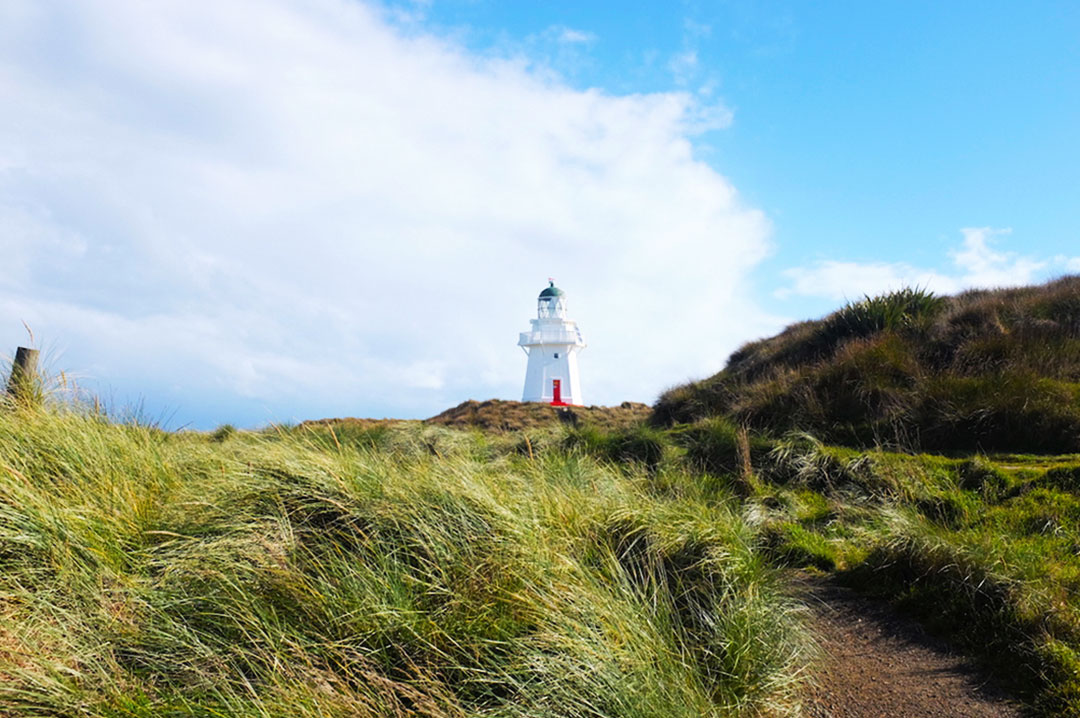
On the way, you can see lazy fur seals who don’t pay any attention to tourists and just keep lying on the shore. At the lighthouse, there is a steep precipice, from which you can clearly see the waves crashing against the cliffs far below. Like magic, a double rainbow appeared. The colors were so contrasting that they were hard on your eyes.
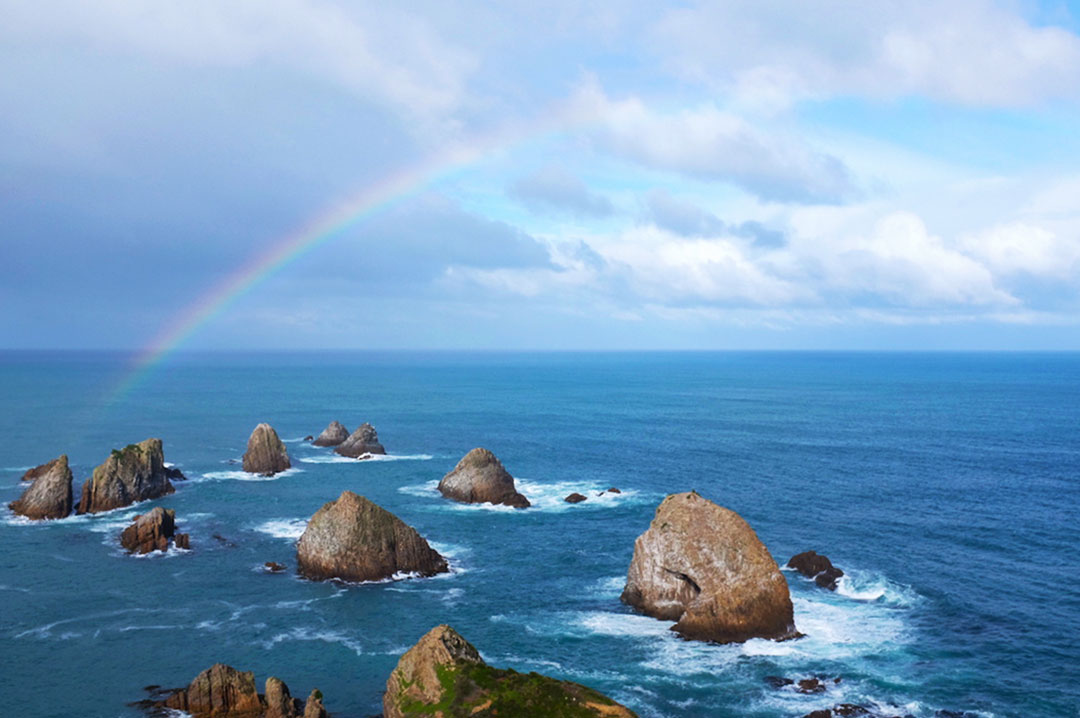
Then we drove to the beach at Cannibal Bay. Our guide told us that if we were lucky we would catch a glimpse of some sea lions. And we were lucky indeed—the sea lions emerged from the sea foam towards us. Sea lions look rather formidable and are larger than the average seal—they can easily crush a person with their bodies. Tourists are advised not to come closer than 10 meters from them. I must admit that we violated this rule. One sea lion was particularly brave and crawled towards us himself, but then stopped and growled to warn us to remain cautious and not to get any closer.
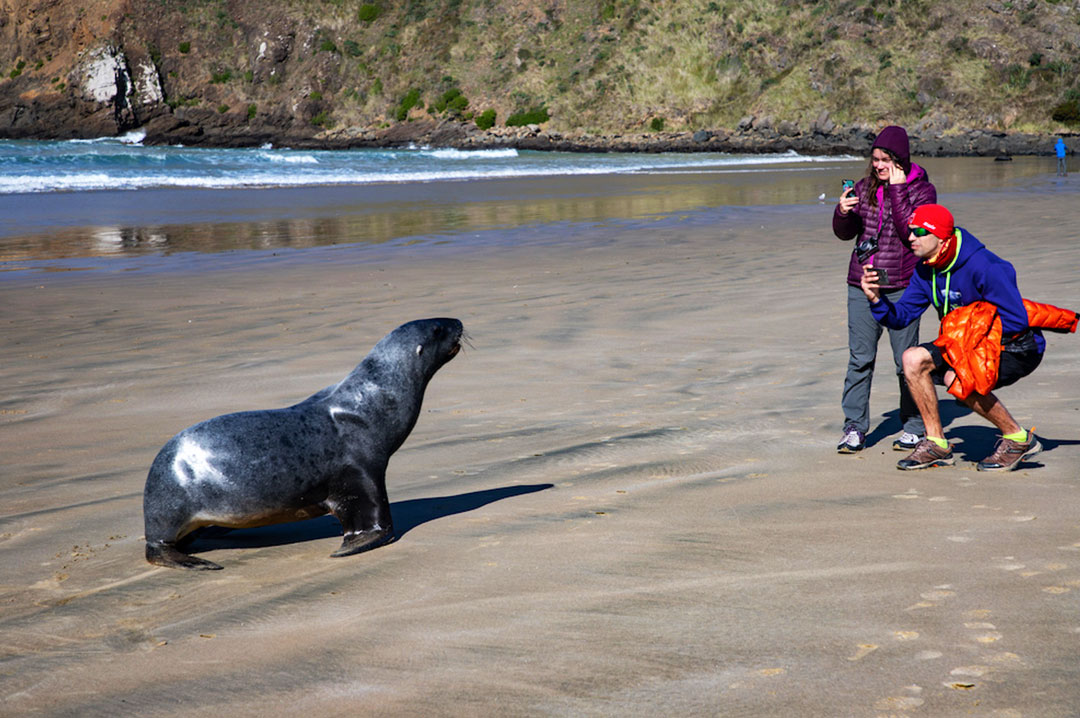
I really didn’t want to leave this place, but we were set to travel to the Otago region to see the Moeraki Boulders. These spherical boulders are a true natural phenomenon. They were formed from rocks after they were subject to water erosion. Imagine a 300-meter strip of stone balls lying on the sand.
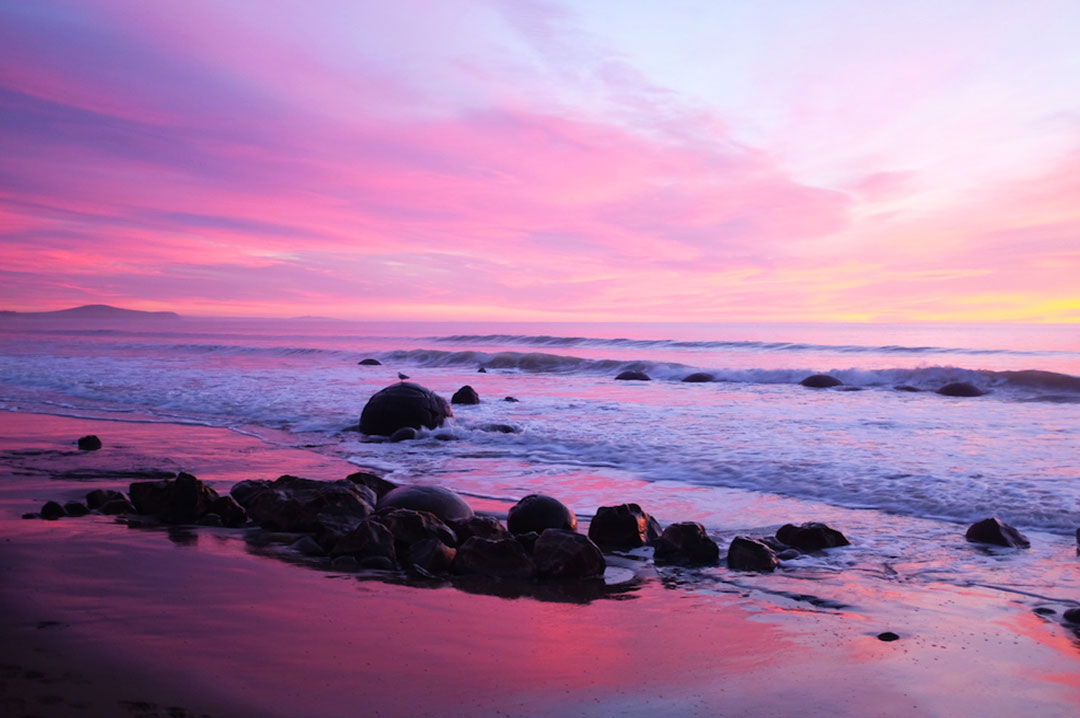
At sunrise, it’s simply out of this world! No wonder photographers come here from all corners of the globe. We also watched the sunrise while sitting on the boulders—it was the perfect finale to our journey.
During my first few days in New Zealand, I tried to pinch myself, so I wouldn’t be too charmed and confuse tourism with immigration. I tried to find drawbacks. But then I gave up my search. I found myself in a society where they treasure and share all the values that are important to me, for example: spending less time with gadgets and more time with each other; playing sports and going on hikes (both children and pensioners); caring for nature and each other.
The description of our trip sounds like the synopsis of an adventure film: we were attacked by kea parrots in the mountains; we came within an arm’s length of sea lions on the beach; we climbed into caves with glow worms; we gazed at the night sky in search of planets; we dug up hot springs in the sand; we embraced giant 2,000-year-old kauri trees.
I don’t know if I convinced you that a trip to New Zealand is worth the money and time you will spend. You’d better go and see for yourself!

